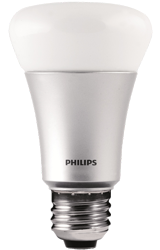An Amazon Echo Dot has arrived in the house. We're still in the find-out-if-it-is-useful period, but to help us through that there's plenty of party tricks to keep us entertained.
After we'd played with asking Alexa trivia questions, and to play specific music or radio stations, it was time to hook it up to our Philips Hue lighting and Honeywell Evohome heating systems.
First step is to download the Alexa app, and go to the Smart Home menu option. Amazon calls the integrations into Alexa 'skills', presumably for trademark reasons. The Hue skill is called Hue, but the Evohome skill is called Honeywell Total Connect Comfort, and both require linking to your cloud accounts for those systems. Once the skills are enabled I hit the 'Discover devices' button, and the Evohome devices were found straight away. For the Hue devices I need to press the button on the Hue hub first, but then Alexa was able to find them.
Alexa enables you to control your Evohome system through both activating modes ("Alexa, turn on Economy mode") and through setting individual zones ("Alexa, set Kitchen to 21 degrees"). You can also nudge a zone up or down ("Alexa, raise Lounge by 2 degrees"), and turn the hot water on and off ("Alexa, turn off hot water"). The zones and modes you've set up in Evohome are automatically brought into Alexa as groups.
What you can't do with Alexa and Evohome is monitor the current status of the system. For example you can't ask what temperature a zone is currently, and you can't ask if a mode is activated or not.
Alexa enables you to control your Hue system through both activating scenes ("Alexa turn on scene Movies") and through setting individual lights or rooms ("Alexa, turn Dining light on"). Any collections of lights that you've put into a Room in your Hue system are automatically brought into Alexa as groups.
What you can't do with Alexa and Hue is set lights to specific colours. For example you can't tell Alexa to turn a light to Red, you can to pre-set a scene with that light as Red and activate that scene.
After we'd played with asking Alexa trivia questions, and to play specific music or radio stations, it was time to hook it up to our Philips Hue lighting and Honeywell Evohome heating systems.
First step is to download the Alexa app, and go to the Smart Home menu option. Amazon calls the integrations into Alexa 'skills', presumably for trademark reasons. The Hue skill is called Hue, but the Evohome skill is called Honeywell Total Connect Comfort, and both require linking to your cloud accounts for those systems. Once the skills are enabled I hit the 'Discover devices' button, and the Evohome devices were found straight away. For the Hue devices I need to press the button on the Hue hub first, but then Alexa was able to find them.
Alexa enables you to control your Evohome system through both activating modes ("Alexa, turn on Economy mode") and through setting individual zones ("Alexa, set Kitchen to 21 degrees"). You can also nudge a zone up or down ("Alexa, raise Lounge by 2 degrees"), and turn the hot water on and off ("Alexa, turn off hot water"). The zones and modes you've set up in Evohome are automatically brought into Alexa as groups.
What you can't do with Alexa and Evohome is monitor the current status of the system. For example you can't ask what temperature a zone is currently, and you can't ask if a mode is activated or not.
Alexa enables you to control your Hue system through both activating scenes ("Alexa turn on scene Movies") and through setting individual lights or rooms ("Alexa, turn Dining light on"). Any collections of lights that you've put into a Room in your Hue system are automatically brought into Alexa as groups.
What you can't do with Alexa and Hue is set lights to specific colours. For example you can't tell Alexa to turn a light to Red, you can to pre-set a scene with that light as Red and activate that scene.


















